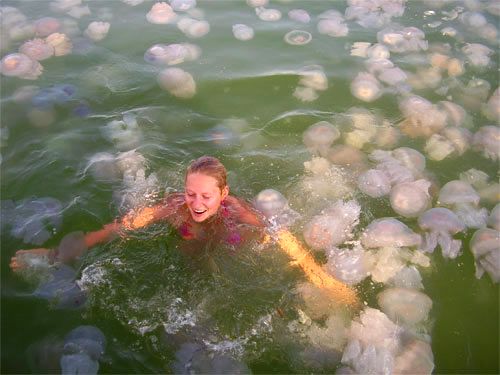Jellyfish threaten nuclear power plants
A few days ago, an Israeli coastal power plant was forced to close after jellyfish entered the sea cooling system.
>>>British nuclear plant closed for jellyfish

Jellyfish becomes a threat to nuclear power plants - Photo: Hemmy.net
The same incident also caused two Scottish nuclear reactors to temporarily shut down last week. A week earlier, the reactor in Shimane, Japan, was also haunted by jellyfish. These coincidence-like events are making scientists worry about the prospect of jellyfish 'population' that may be exploding in conditions of sea warming and acidification in oceans. .
Jellyfish expert Monty Graham in the Ocean Laboratory at Dauphin Island (USA) said the world once recorded dozens of cases of jellyfish that caused nuclear reactors to shut down (partially or fully ) in the past few decades. Jellyfish do not let go of desalination plants. And expert Steve Haddock of the Monterrey Bay Marine Research Institute recounted an Australian power plant shut down because of this creature in 1937. In fact, all of the plants discharged water into the sea. , and experts when building factories have already installed filters to remove jellyfish as well as objects caught in the drain. However, no matter how strong the filtering system is, it is not against the "attack " of a jellyfish army, according to MSNBC, quoted Mr. Graham.
The jellyfish community often increases in quantity during the spring-summer months, and this may explain the many consecutive nuclear reactors stalled because of this mollusk. However, these events are not enough to conclude that the earth is facing the invasion of jellyfish. Experts now only pay attention to this phenomenon and start the relevant research. Claudia Mills, a jellyfish biologist at the University of Washington, says it has recorded a number of cases of jellyfish communities in several localities. For example, they have expanded their territories in the Mediterranean over the past few decades. However, Mills must admit that the science is blind about the evolution of jellyfish numbers in many parts of the world. It is also possible that global warming has strongly impacted their proliferation, but it does not rule out that ' sabotaging' jellyfish reactors appear more frequently in the press due to the increasing number of nuclear power plants. personnel grow on the coast.
As for nuclear power plants, administrators still have no specific measures to deal with ' jellyfish '. Some argue that it may be necessary to install multi-layer filters and the system blows with a nozzle to push jellyfish to the water surface, where they shrink. Or simply, when there are many jellyfish, close the reactor door, Graham concludes.
- Nuclear power plants worry about being attacked by jellyfish
- Jellyfish species can 'knock down' American carriers
- Jellyfish makes the nuclear plant shut down
- Potential threat from old nuclear plants
- Vietnam nuclear power needs to have standards
- The first floating nuclear power plant will operate in 2016
- Iran-Russia agreed to build 2 more nuclear power plants
- Nuclear power plant floating on water
- Germany closed all nuclear power plants by 2022
- Vietnam was back in time to build the first nuclear power
- Situation of world nuclear technology
- Russia tested floating nuclear power plant
 Vietnam 5th Asian champion on fuel-efficient vehicles
Vietnam 5th Asian champion on fuel-efficient vehicles We can read all NASA studies completely free of charge
We can read all NASA studies completely free of charge Singer and songwriter Bob Dylan won the 2016 Nobel Prize for Literature
Singer and songwriter Bob Dylan won the 2016 Nobel Prize for Literature Scientific revolution in Asia
Scientific revolution in Asia